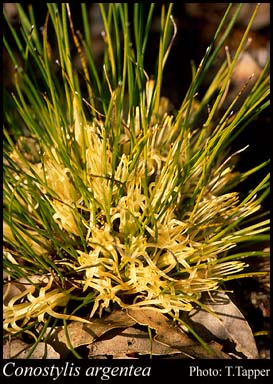- Reference
- Fl.Austral. 45:459 (1987)
- Conservation Code
- Not threatened
- Naturalised Status
- Native to Western Australia
- Name Status
- Current
Rhizomatous, tufted perennial, grass-like or herb, 0.07-0.25 m high. Fl. cream-other, Jul to Aug. Sandy loam, clayey loam, gravel, yellow or white sand.







Scientific Description
Leaves round (leaves terete), 80-130 mm long, 0.8-1 mm wide; bristles or hairs on the leaf margin absent; hairs on the surface of the leaf absent (leaf surfaces glabrous). Scape absent. Inflorescence subtended by a bract 10-12 mm long, with one flower; floral bracts 10-12 mm long; pedicels sessile; flowers 35-65 mm long. Perianth hairy, radially symmetrical, uniformly coloured or suffused with a darker colour over the base colour, white to cream, with six more or less equal tepals, the inner segments 15-20 mm long. Stamens six, in one level; filaments 7-8 mm long; anther 5.5-5.7 mm long, without an appendage. Style 25-38 mm long. Flowers in July or August. Occurs in the Coolgardie, Avon Wheatbelt, Mallee and Esperance IBRA bioregion(s), of the South-west Botanical Province.
Distribution
- IBRA Regions
- Avon Wheatbelt, Coolgardie, Esperance Plains, Mallee.
- IBRA Subregions
- Eastern Mallee, Fitzgerald, Katanning, Merredin, Recherche, Southern Cross, Western Mallee.
- Local Government Areas (LGAs)
- Bruce Rock, Corrigin, Dumbleyung, Esperance, Gnowangerup, Jerramungup, Kent, Kondinin, Kulin, Lake Grace, Merredin, Narembeen, Pingelly, Ravensthorpe, Trayning, Wickepin, Yilgarn.